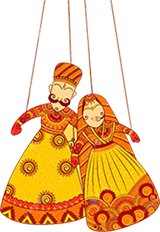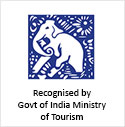Costumes of Rajasthan
The land of vibrant colours, Rajasthan is fun filled with the bursting bazaars, fair an festivals and the different costumes worn and produced in the traditional manners. The bright costumes of the village men and the tribal folks makes up for a place all colourful from red, dazzling yellow, green, orange to blue highlighted by the ornamental Gota or the Zari.
The dresses are mostly influenced by the climate and economy, status and profession of the peoples. The traditional dresses are the potia, dhoti, banda, angrakha, bugatari, pachewara, khol, dhabla among the Hindus and burkha, achkan for the muslims. Rajasthani daily wear that includes the Sarees, Odhnis and Turban are often made from textiles using block printed or tie and dye technique.
Turban: The headgear of the Rajasthani men denotes the geographical location, terrains and the climatic influence. Known as Pagari, the turban is available in about 1,000 styles and types. The turban signifies the class and caste of the wearer and there are specific turbans for specific occasion. A traditional Pagari is usually of one colour and is almost 82 feet long with a width of 8 inches. A safa is a shorter version of the Turban and is usually broader in its width.
Men's Attire: The head turban of different style depending on the region and caste and the Angrakhi or Achkan consists of the upper garment and Dhoti or Pyjamas on the lower front makes the complete male outfits.
Women's Attire: The standard for the fairer gender is a four piece dress which consists of a ghagra or the skirt, the Odhni or head cloth, the Kurtior the blouse like material and Kurti, the long loose blouse. The Odhni is 10 feet long and tucked in the skirt on one side while the other is taken the head and the right shoulder. Women generally wear chappals or sandals more commonly called Jhutis. But the ladies of high families wear colourful sandals with gold threads and stars. The costumes are very colourful and attractive.
Pilia: A decorated Odhni with a yellow shade and central lotus motif coloured in red is termed as Pilia and gifted as a tradition from the Parents to their daughter on the birth of a child.
Ornaments: The use of Ornaments with the costumes as a rule dated back to the prehistoric times. As time elapsed new design and variety replaced the old ones. As a tradition both men and women use to wear ornaments but the men folks had by now given up the habit and it remains only with the women now. Ornaments of both Gold and Silver are prominent in the state. On an average, a woman generally wears ornaments like necklace, rings, earrings and nose rings. On special occasions exquisitely designed ornaments are worn on most part of the body.
Upon arrival our representative will meet you at Delhi international airport and escort to the hotel
for assistance with check in process. Delhi, the capital city of India, is located in northern part of India
and sets on the bank of River Yamuna. The city has its own historical importance for the fact that it
has been the home to Mughal Empire for a long time; its rulers had built some magnificent monuments
here. Overnight stay is at hotel in Delhi.









